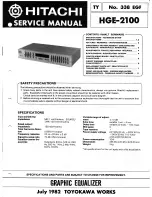
System Settings
For example, Hurricane Electric provides what they call “regular” tunnels and “BGP” tunnels. For
Equalizer, you would choose a “regular” Hurricane Electric tunnel, which is a 6in4 tunnel.
A 6in4 tunnel allows a user to access the IPv6 internet by tunneling over an existing IPv4
connection from an IPv6-enabled host to one of Hurricane Electric's IPv6 routers on the internet.
Once a tunnel is established, the IPv6 enabled host sends IPv6 traffic over the local IPv4 network
by encapsulating IPv6 packets inside IPv4 packets. These packets are sent to the IPv6 routers
operated by the tunnel broker, unencapsulated, and then the IPv6 packets are forwarded to the
IPv6 internet.
Note
- You can use IPv6 cluster addresses without establishing a tunnel on Equalizer if your organization already has
established an IPv6 tunnel and Equalizer can send IPv6 traffic through the local tunnel endpoint. In this configuration,
you would simply assign cluster IPv6 addresses from the subnet associated with the already established tunnel and
route the IPv6 traffic through the tunnel endpoint. This is done with the standard subnet configuration commands.
Configuring an IPv6 Tunnel
Setting up an IPv6 tunnel on Equalizer is basically a two step process:
1. Configure a VLAN over which Equalizer can reach the IPv4 Internet, and request a "6in4" tun-
nel from a tunnel broker.
2. After you receive the tunnel configuration information from the broker, set up the tunnel
endpoint on Equalizer.
Once the tunnel is configured, you can perform additional tasks required to get Equalizer clusters
on the IPv6 Internet, including:
l
Assigning cluster IPv6 addresses from the subnet address range provided by the tunnel
broker.
l
Updating DNS to point to the tunnel broker’s DNS servers.
Creating a "6in4" IPv6 Tunnel (CLI)
1. Configure a VLAN and subnet to use as the local IPv4 endpoint for the tunnel using VLAN con-
text commands (See
). Note the following:
l
The IPv4 address assigned to the subnet must either be a routable IPv4 address or resolve
to a routable IPv4 address via Network Address Translation (NAT) on another device.
l
The routable IPv4 address associated with this VLAN is the one that is supplied to the tunnel
broker as the local endpoint of the tunnel. Changes to this address must be coordinated with
the tunnel broker.
l
The ports (both tagged and untagged) that are assigned to this VLAN are the ports on which
the IPv6 address block assigned by the tunnel broker will be accessible.
2. Request a "regular" tunnel using Hurricane Electric’s website at:
When providing the local IPv4 endpoint address, use the IPv4 address assigned to the
VLAN subnet created in Step 1, or its routable NAT address.
310
Copyright © 2014 Coyote Point Systems, A Subsidiary of Fortinet, Inc.
Summary of Contents for Equalizer GX Series
Page 18: ......
Page 32: ...Overview 32 Copyright 2014 Coyote Point Systems A Subsidiary of Fortinet Inc ...
Page 42: ......
Page 52: ......
Page 64: ......
Page 72: ......
Page 76: ......
Page 228: ......
Page 238: ......
Page 476: ......
Page 492: ......
Page 530: ......
Page 614: ......
Page 626: ......
Page 638: ......
Page 678: ......
Page 732: ...Using SNMP Traps 732 Copyright 2014 Coyote Point Systems A Subsidiary of Fortinet Inc ...
Page 754: ......
Page 790: ......
Page 804: ......
Page 842: ......
Page 866: ......
















































